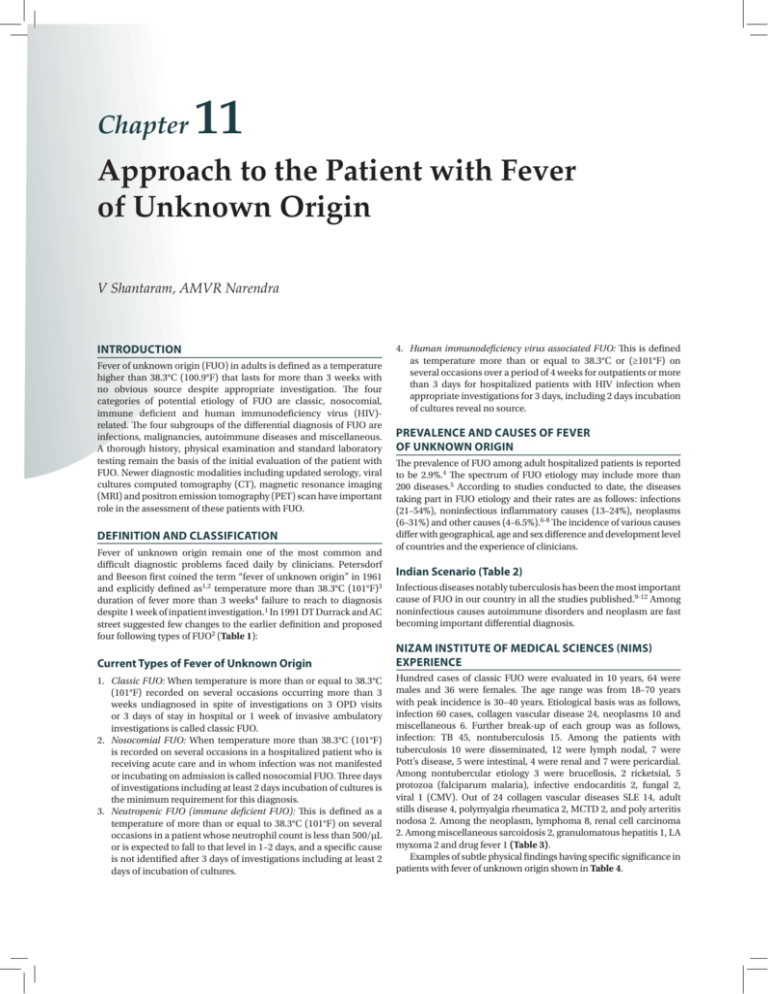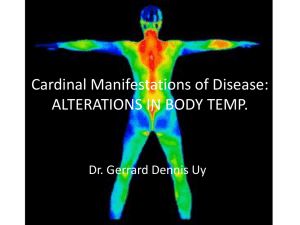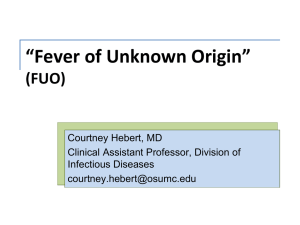Approach to the Patient with Fever of Unknown Origin
advertisement

Chapter 11 Approach to the Patient with Fever of Unknown Origin V Shantaram, AMVR Narendra INTRODUCTION Fever of unknown origin (FUO) in adults is defined as a temperature higher than 38.3°C (100.9°F) that lasts for more than 3 weeks with no obvious source despite appropriate investigation. The four categories of potential etiology of FUO are classic, nosocomial, immune deficient and human immunodeficiency virus (HIV)related. The four subgroups of the differential diagnosis of FUO are infections, malignancies, autoimmune diseases and miscellaneous. A thorough history, physical examination and standard laboratory testing remain the basis of the initial evaluation of the patient with FUO. Newer diagnostic modalities including updated serology, viral cultures computed tomography (CT), magnetic resonance imaging (MRI) and positron emission tomography (PET) scan have important role in the assessment of these patients with FUO. DEFINITION AND CLASSIFICATION Fever of unknown origin remain one of the most common and difficult diagnostic problems faced daily by clinicians. Petersdorf and Beeson first coined the term “fever of unknown origin” in 1961 and explicitly defined as1,2 temperature more than 38.3°C (101°F)3 duration of fever more than 3 weeks4 failure to reach to diagnosis despite 1 week of inpatient investigation.1 In 1991 DT Durrack and AC street suggested few changes to the earlier definition and proposed four following types of FUO2 (Table 1): 4. Human immunodeficiency virus associated FUO: This is defined as temperature more than or equal to 38.3°C or (≥101°F) on several occasions over a period of 4 weeks for outpatients or more than 3 days for hospitalized patients with HIV infection when appropriate investigations for 3 days, including 2 days incubation of cultures reveal no source. PREVALENCE AND CAUSES OF FEVER OF UNKNOWN ORIGIN The prevalence of FUO among adult hospitalized patients is reported to be 2.9%.4 The spectrum of FUO etiology may include more than 200 diseases.5 According to studies conducted to date, the diseases taking part in FUO etiology and their rates are as follows: infections (21–54%), noninfectious inflammatory causes (13–24%), neoplasms (6–31%) and other causes (4–6.5%).6-8 The incidence of various causes differ with geographical, age and sex difference and development level of countries and the experience of clinicians. Indian Scenario (Table 2) Infectious diseases notably tuberculosis has been the most important cause of FUO in our country in all the studies published.9-12 Among noninfectious causes autoimmune disorders and neoplasm are fast becoming important differential diagnosis. Current Types of Fever of Unknown Origin NIZAM INSTITUTE OF MEDICAL SCIENCES (NIMS) EXPERIENCE 1. Classic FUO: When temperature is more than or equal to 38.3°C (101°F) recorded on several occasions occurring more than 3 weeks undiagnosed in spite of investigations on 3 OPD visits or 3 days of stay in hospital or 1 week of invasive ambulatory investigations is called classic FUO. 2. Nosocomial FUO: When temperature more than 38.3°C (101°F) is recorded on several occasions in a hospitalized patient who is receiving acute care and in whom infection was not manifested or incubating on admission is called nosocomial FUO. Three days of investigations including at least 2 days incubation of cultures is the minimum requirement for this diagnosis. 3. Neutropenic FUO (immune deficient FUO): This is defined as a temperature of more than or equal to 38.3°C (101°F) on several occasions in a patient whose neutrophil count is less than 500/µL or is expected to fall to that level in 1–2 days, and a specific cause is not identified after 3 days of investigations including at least 2 days of incubation of cultures. Hundred cases of classic FUO were evaluated in 10 years, 64 were males and 36 were females. The age range was from 18–70 years with peak incidence is 30–40 years. Etiological basis was as follows, infection 60 cases, collagen vascular disease 24, neoplasms 10 and miscellaneous 6. Further break-up of each group was as follows, infection: TB 45, nontuberculosis 15. Among the patients with tuberculosis 10 were disseminated, 12 were lymph nodal, 7 were Pott’s disease, 5 were intestinal, 4 were renal and 7 were pericardial. Among nontubercular etiology 3 were brucellosis, 2 ricketsial, 5 protozoa (falciparum malaria), infective endocarditis 2, fungal 2, viral 1 (CMV). Out of 24 collagen vascular diseases SLE 14, adult stills disease 4, polymyalgia rheumatica 2, MCTD 2, and poly arteritis nodosa 2. Among the neoplasm, lymphoma 8, renal cell carcinoma 2. Among miscellaneous sarcoidosis 2, granulomatous hepatitis 1, LA myxoma 2 and drug fever 1 (Table 3). Examples of subtle physical findings having specific significance in patients with fever of unknown origin shown in Table 4. Chapter 11 Approach to the Patient with Fever of Unknown Origin Section 1 TABLE 1 │ Summary of classification and major factors of the four subtypes of fever of unknown origin Classic FUO Nosocomial FUO Immunodeficient FUO HIV-related FUO Definition >38°C 3 wk, > 2 visits or 3d in hospital >38°C, 3d, not present or incubating on admission >38oC, 3d, negative cultures after 48 hrs with < 1,000 PMN /µL >38°C <3w for inpatients, HIV infection confirmed Patient location Community, clinic or hospital Acute care hospital Hospital or clinic Community, clinic or hospital Leading causes Infections, inflammatory conditions, cancer, undiagnosed, habitual hyperthermia Nosocomial infections, postoperative complications, drug fever Majority due to infections, but cause documented in only 40–60% (HIV primary infection), typical and atypical mycobacteria, CMV, lymphomas, toxoplasmosis, cryptococcosis History emphasis Travel, contacts, animal and insect exposure, medications, immunizations, family history, cardiac valve disorder Operations and procedures, devices, anatomic considerations, drug treatment Stage of chemotherapy, drugs administered, underlying immunosuppressive disorder Drugs, exposures, risk factors, travel contacts, stage of infection Examination emphasis Fundi, oropharynx, temporal artery, abdomen, lymph nodes, spleen, joints, skin, nails, genitalia rectum or prostate, lower limb deep veins. Wound, drains, devices, sinuses, urine Skin folds, IV sites, lungs, perianal area Mouth, sinuses, skin, lymph nodes, eyes, lungs perianal area Investigation emphasis Imaging, biopsies, sedimentation rate, skin testes Imaging, bacterial cultures CXR, bacterial cultures Blood and lymphocyte count; serologic test: CXR; stool examination; biopsies of lung, bone marrow and liver for cultures and cytological tests, brain imaging Management Observation, outpatient temperature chart, investigations, avoidance of empirical drug treatments Depends on situation Antimicrobial treatment Antimicrobial protocols, vaccines, revision of treatment regimens, good nutrition Time course of disease Months Weeks Days Weeks to months Tempo of investigation Weeks Days Hours Days to weeks TABLE 2 │ Comparison of three major etiologic categories of fever of unknown origin in various series reported in India Handa et al9 D Kejarwal et al10 Dipanjan Bandyopadhyay et al12 Infections 43.8% 53% 58.53% Collagen vascular disease 15.7% 11% 11% Neoplasms 8.3% 17% 22 TABLE 3 │ Common etiologies of fever of unknown origin Infections Tuberculosis especially extrapulmonary, abdominal abscess, pelvic abscess, dental abscesses, endocarditis, osteomyelitis, sinusitis, prostatitis, viral (cytomegalovirus, Epstein-Barr, HIV) ricketsial, fungal, malaria, typhoid and kala azar Malignancies Lymphoma, chronic leukemia, metastatic cancer, renal cell carcinoma, colon cancer, hepatoma and sarcomas Autoimmune conditions Adult still’s disease, polymyalgia rheumatica, temporal arteritis, SLE, RA, Reiter’s syndrome, vasculitides and inflammatory bowel disease Miscellaneous Drug-induced fever, factitious fever sarcoidosis, granulomatous hepatitis, DVT and PTE DIAGNOSTIC APPROACH AND CLINICAL PERSPECTIVE Because FUOs are caused by such a wide variety of disorders, the diagnostic approach to the FUO patient is often extensive consisting of three phases:13-15 1. Initial evaluation should include relevant FUO history as well as physical examination that look particularly for diagnostic finding relevant to FUO (Table 3). Initial nonspecific laboratory tests provide clues pointing toward a particular diagnosis while simultaneously eliminating other diagnosis. 2. Second phase of FUO evaluation consists of a focused history and comprehensive physical examination with additional relevant lab tests. 45 Infectious Diseases Section 1 Flow chart 1: Algorithm for the diagnosis of fever of unknown origin 46 Chapter 11 Approach to the Patient with Fever of Unknown Origin Section 1 TABLE 4 │ Examples of subtle physical findings having specific significance in patients with fever of unknown origin Body site Physical finding Diagnosis Head Sinus tenderness Sinusitis Temporal artery Nodules, reduced pulsation Temporal arteritis Oropharynx Ulceration, tender tooth Disseminated histoplasmosis, periapical abscess Fundi or conjunctiva Choroid tubercle, petechiae, Roth’s spot Disseminated granulomatosis, endocarditis Neck and axilla All lymph nodes including Virchow’s. Infections (Koch’s, viral), sarcoidosis, SLE, metastatic cancer, lymphoma, leukemia Thyroid Enlargement, tenderness Thyroiditis Heart Murmur Infective endocarditis Abdomen Enlarged liver; lymph nodes, splenomegaly Lymphoma, endocarditis, disseminated granulomatosis Rectum Perirectal tenderness; prostatic tenderness Abscess Genitalia Testicular nodule epididymal nodule Polyarteritis nodosa, disseminated granulomatosis Lower extremities Deep venous tenderness Thrombosis or thrombophlebitis Skin and nails Petechiae, splinter hemorrhages, subcutaneous nodules, clubbing Vasculitis, endocarditis 3. Third phase of FUO work-up is the definitive diagnostic testing including specific lab tests and biopsy to confirm the diagnosis (Flow chart 1) shows algorithm for FUO work-up. TREATMENT OF FEVER OF UNKNOWN ORIGIN REFERENCES The emphasis in patients with classic FUO is on continued observa­ tion and examination with avoidance of “Shotgun” empirical therapy. However, vital signs instability or neutropenia is an indication for empirical therapy with fluroquinolone plus piperacillin. If Mantoux test is strongly positive and granulomatous disease is suggested (and sarcoid seems unlikely) then a therapeutic trial for tuberculosis should be undertaken with treatment continued for up to 6 weeks. A failure of the fever to respond over this period suggests other alternative diagnosis. A response of rheumatic fever and still’s disease to aspirin and NSAIDs may be dramatic. The effects of glucocorticoids on temporal arteritis and polymyalgia rheumatica and granulomatous hepatitis are equally dramatic. The initiation of empirical therapy, doesn’t mark the end of the diagnostic work-up, rather it commits the physician to continued thoughtful reexamination and evaluation. Patience, compassion, equanimity, vigilance and intellectual flexibility are indispensable attributes for the clinician in dealing successfully with FUO. CONCLUSION One of the problems most frequently encountered in medical practice is the diagnosis of prolonged fever with or without local signs of disease. This problem perplexes both the physician and the patient and is labeled as FUO. The definition, classification and clinical approach, diagnosis and treatment have been discussed. It is important to realize FUO may represent uncommon manifestation of common disease. Hence the work-up should be cost effective and thoughtful and clinically appropriate. Empirical treatment sometimes may be justified, however one should remember that treatment should not be worse than disease. In India infections notably extra pulmonary tuberculosis is the most common cause of FUO. Noninfectious causes like collagen vascular disease and neoplasms are becoming important differential diagnosis. 1. Petersdorf RG, Beeson PB. Fever of unexplained origin: report on 100 cases. Medicine (Baltimore). 1961;40:1-30. 2. Harrison's Fever of unknown origin. In: Longo D, Fauci A, Kasper D (Eds). Principles of Internal Medicine, 18th edition. Mc Graw Hill; 2012. pp.158-64. 3. Druack DT, Streat AC. Fever of unknown origin reexamined and redefined. Curr Clin Top Infect Dis. 1991;11:35-51. 4. Tabak F, Mert A, Celik AD, et al. Fever of unknown origin in Turkey. Infection. 2003;31(6):417-20. 5. Gaeta GB, Fusco FM, Nardiello S. Fever of Unknown origin: a systematic review of literature for 1995–2004. Nucl Med Commun. 2006;27(3):20511. 6. Mourad O, Palda V, Detsky AS. A comprehensive evidence based approach to FUO. Arch Intern Med. 2003;163(5):545-51. 7. Knockaert DC, Vanneste CJ, Bobloecrs JJ. Fever of unknown origin in elderly patients. J Am Geriatr Soc. 1993;41:1187-92. 8. Knockaert DC, Vanderschueren S, Blockmans D. Fever of unknown origin in adults: 40 years on. J intern Med. 2003;253(3):263-75. 9. Handa R, Singh S, Singh N. Fever of unknown origin: a prospective study. Trop Doct. 1996;26:169-70. 10. Kejariwal D, Sarker N, Chakravarti SK, et al. Pyrexia of unknown origin: a prospective study of 100 cases. J Postgrad Med. 2001;47:104-7. 11. Joshi N, Rajeshwari K, Dubay AP, et al. Clinical spectrum of fever of unknown origin among Indian children. Ann Trop Pediatr. 2008;28:2616. 12. Bandyopadhyay D, Bandyopadyay R, Paul Roy D. The etiological study of fever of unknown origin in patients admitted to medicine ward of a teaching hospital of eastern India. Journal of Global Infections Diseases. 2011; 3(4):329-33. 13. Bleeker Rovers CP, Vos FJ, de Kleijn EM, et al. A prospective multicentre study of FUO: yield of structured diagnostic protocol. Medicine. 2007;86(1):26-38. 14. de Kleijn EM, Vandenbroucke JP, van der Meer JW. Fever of unknown origin (FUO) I. A prospective multi-centric study of 167 patients with FUO, using fixed epidemiologic entry criteria. The Netherlands FUO Study Group. Medicine (Baltimore). 1997;76(6):392-400. 15. de Kleijn EM, van Lier HJ, van der Meer JW, et al. Fever of unknown origin (FUO) II. Diagnostic procedures in a prospective multi-centric study of 167 patients with FUO. Medicine (Baltimore). 1997;76(6):40114. 47










